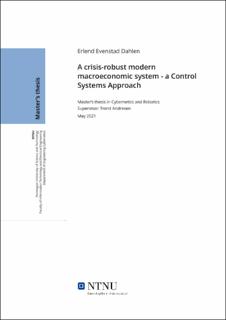| dc.contributor.advisor | Andresen, Trond | |
| dc.contributor.author | Dahlen, Erlend Evenstad | |
| dc.date.accessioned | 2021-09-25T16:31:55Z | |
| dc.date.available | 2021-09-25T16:31:55Z | |
| dc.date.issued | 2021 | |
| dc.identifier | no.ntnu:inspera:76427839:45168049 | |
| dc.identifier.uri | https://hdl.handle.net/11250/2783264 | |
| dc.description.abstract | Det finansielle systemet er viktig for koordinering av mennesker, prosjekter og ressurser, og det har derfor en katastrofal virkning når det slutter å fungere i en finanskrise. Som en makroøkonomisk utfordring erkjennes det at USA (og verden) for tiden gjennomgår en langsiktig gjeldskrise hvor rentene er på null prosent, slik at pengepolitikken må vurderes på nytt. For å demonstrere hvordan en slik langsiktig gjeldskrise kan unngås, undersøker denne oppgaven to tilnærminger basert på kontroll av henholdsvis pengemengde og pengeshastighet. Dette arbeidet utvider modellen av et moderne finanssystem ved å dekke gapet mellom gjeldskrise simuleringer og reformforslag.
En makroøkonomisk modell bestående av en sentralbank, banker, et finansmarked og en realøkonomi er implementert basert på en etablert stock-flow metode fra eksisterende litteratur. Modellen brukes først til å simulere en gjeldskrise, og deretter for å sammenligne de to foreslåtte tilnærmingene for å unngå krisen. I tilnærmingen basert på Modern Monetary Theory (MMT) kontrollerer sentralbanken pengemengden, mens i tilnærmingen basert på digitale sentralbankpenger (DSP) og et negativt gebyr på penger, er pengeshastighet kontrollvariabelen. I denne oppgaven blir de to tilnærmingene evaluert ved å sammenligne finansiell stabilitet, finansmarkedets rolle og tilnærmingenes gyldighet. I simuleringen for MMT-tilnærmingen blir den statlige gjeldsbelastningen (tilbakebetaling og renter) uholdbar, og finansmarkedet "suger" til seg stadig mer penger. I simuleringen med et negativt gebyr investerer finansmarkedet penger raskere, men det er et skifte mot høyere forbruk. Sentralbanken er i stand til å holde renten på et høyere nivå med en negativ avgift. Siden renten er en proxy for stimulering av økonomien, kan den negative avgiften kontinuerlig stimulere økonomien, mens MMT-tilnærmingen gradvis blir mindre effektiv. Resultatene fra denne oppgaven viser at kontroll av pengehastigheten fører til det mest robuste systemet, og viser viktigheten av denne kontrollvariabelen for sentralbanker. | |
| dc.description.abstract | The financial system is essential to the coordination of people, projects and resources, and it therefore has a devastating impact when it stops functioning properly in a financial crisis. As a macroeconomic challenge, it is recognized that the United States(and the world) are currently undergoing a long-term debt crisis where interest rates are at zero percent so that monetary policy needs to be re-evaluated. To demonstrate how such a long-term debt crisis can be avoided, this thesis investigates two approaches based on control of money stock and money velocity, respectively. This work expands the model of a modern financial system by bridging the gap between debt crisis simulations and reform proposals.
A macroeconomic model consisting of a central bank, banks, a financial market and a real economy is implemented based on an established stock-flow modelling framework from the existing literature. The model is first used to simulate a debt crisis, and then to compare the two proposed approaches for avoiding the crisis. The first approach is based on Modern Monetary Theory(MMT), where the central bank controls money stock, while the second approach is based on central bank digital currencies(CBDC) and a negative fee on money, where money velocity is the control variable. In this thesis, the two approaches are evaluated by comparing financial stability, the role of the financial market and their validity. In the simulation for the MMT approach, the government debt service(repayment and interest) becomes unsustainable, and the financial market increasingly "soaks" up money. In the simulation with a negative fee, the financial market deploys money faster, but there is a shift towards higher consumption. The central bank is able to keep the interest rate at a higher level with a negative fee. Since the rate is a proxy for stimulation of the economy, the negative fee is able to continuously stimulate the economy, whereas the MMT approach becomes gradually less efficient. The results from this thesis show that control of money velocity leads to the most crisis-robust system, and demonstrate the importance of this control variable for central banks. | |
| dc.language | eng | |
| dc.publisher | NTNU | |
| dc.title | A crisis-robust modern macroeconomic system - a Control Systems Approach | |
| dc.type | Master thesis | |
